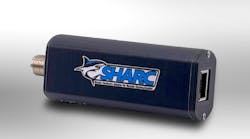Industrial necessity is often the mother of development. The need to capture a given data point from a machine with a sensor drove Chris Misztur, founder, and Chris Eudy, product owner, at Mr. IIoT, to create the Simple Hardware Adapter for Remote Communications (SHARC). “We could integrate with the machine, if it was capable, but that became too costly and cumbersome for a large portion of our customers,” explains Eudy. “For legacy machines, we would add a sensor and then numerous pieces of hardware and software to capture the data into actionable information. The question we asked ourselves was, ‘Why isn’t it simpler to just add a sensor and get its data?’”
Seven years ago, the Digital Manufacturing and Design Innovation Institute (DMDII), which became Manufacturing Times Digital (MxD) in 2019, put out a project call for a “retrofit kit design that allows manufacturers to exchange data with their legacy machines using an open architecture and standards in a low-cost and easily configurable manner,” Misztur recalls.
“At that time, there was a need, as there still is now, to extract data from processes that might be lacking measurement instrumentation,” says Misztur. “I kind of forgot about this project and moved on to PLC-enabled processes to extract data, which presented its own set of obstacles. Then, as we began instrumenting different processes using off-the-shelf hardware, we found that there is still much complexity and cost involved in wiring up the sensors, installing gateways, powering up the hardware, dealing with multiple protocols and data transformations, and then the need to maintain it all. All of this is just to get the data out of OT and into IT’s hands. We thought to ourselves that this will never democratize data access, and our customers won’t be able to truly own these solutions, at least not without the skills that we have. This conglomeration of hardware and software still felt like Industry 3.0.”
Misztur and Eudy then identified the recurring themes they saw across the industry:
1. Lack of skills and experience across OT and IT. Internal cross-functional teams that do exist still lack the experience—meaning that mistakes will be made along the way, lessons will be learned, architectures will be thrown away or worse.
2. Missing or misaligned digital strategy across business units within an organization. This leads to tactics and execution that leave IT succumbing to non-standard implementations.
3. Objections to becoming a digital company. This partially goes back to the first two points, where the speed of pilots and momentum suffer as a result.
The next step was to enable anyone, literally anyone, within a company to participate in a digital strategy. And so SHARC was born.
“Anyone who can turn a screwdriver has the ability to grab two SHARCs, install them and start collecting data they were always curious about,” explains Misztur. “Why two SHARCs? Because that is all it takes to derive everyone’s favorite and most-hated overall-equipment-effectiveness (OEE) metric. Quickly the internal conversations become more about which key performance indicators (KPIs) are truly relevant to our business than waiting for dreaded OEE year-long implementations.”
SHARC turns any sensor that outputs a discrete (PNP, NPN) signal or analog 0-10 V or 4-20 mA and can run on 24 Vdc into a fountain of information. “Take, for example, an encoder,” explains Eudy. “We could take one input from the encoder and turn it into one data point. From that one data point, we could acquire the speed and footage from the encoder.”
System and software integrators could benefit from the SHARC. “System integrators will have an option for additive sensors or tapping existing sensors, if common PLC systems aren’t in the cards,” says Eudy. “Software integrators will be able to add the SHARC to their toolset of capturing data from sensors without having the skill set of a controls engineer.”
The beauty of the SHARC lies in its connectivity and user-friendliness. Simply plug power over Ethernet (PoE) 48 Vdc in one end and plug the sensor in the other. Connect to the SHARC over Bluetooth through your computer browser or through the mobile app. You can use the dynamic-host-configuration-protocol (DHCP) address or set it to static. Configure the MQTT broker, reboot the SHARC and subscribe to the MQTT topic.
“The beauty of the SHARC is that you do not have to be an engineer,” explains Misztur. “If you have ever used a USB-A to USB-C adapter, then you are qualified to install the SHARC.”
The lightweight message-queuing-telemetry-transport (MQTT) protocol and publish/subscribe model accommodate reliable message delivery, making integration between systems seamless and scalable.
“MQTT is an effective means to an end for transporting data points from the edge, as well as commanding SHARC’s configuration over wired or wireless Ethernet,” explains Misztur. “Once SHARC data hits the MQTT broker, the data pipeline toward North is where data is given context. This is where the ability to shape data any way you want happens. We leave this open-ended because interoperability for us is most important.”
SHARC features include:
• compact size (98 mm x 36 mm x 26 mm)
• one channel of configurable inputs
• analog 0-10 V input
• analog 4-20 mA input
• discrete NPN input
• discrete PNP input
• sensor loss detection
• software-configurable input purpose, scaling and calibration
• 100 Mbit Ethernet
• built-in Wi-Fi
• low-energy Bluetooth (BLE)
• configurable over Bluetooth or MQTT
• user-defined data exchange over MQTT
• direct connection to Amazon Web Services (AWS) and Microsoft Azure.
Mr. IIoT will sell two kits of multiple SHARCs in enclosures, all powered by one PoE line with a router in the enclosure. That quantifies as one PoE line, one router and four SHARCs. There will also be an OEE kit that will comprise a router, three SHARCs and an IPC all powered by a single PoE line.
“Our roadmap for this year includes modifying the hardware switch for discrete and analog input to be a software-controlled switch,” explains Eudy. “We also want to add RS-485 for Modbus by the end of the year and possibly RS-232.”





